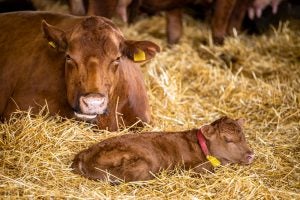‘Tis the season! No, not that season, mud season.
For many cattle producers across the United States, the spring and fall months often brings about the dread of muddy pens or lots. This is especially true in parts of the U.S. that receive greater precipitation levels from rain and snowmelt.
Jerad Jaborek with Michigan State University Extension shares that not only does moisture matter, but animal stocking density, soil type, and ground drainage also influence the severity of mud challenges.
Many of us can relate to the struggles of walking through the mud and trying not to lose our rubber boots to the suctioning force that challenges us with each step. What about the cows and calves? What kind of stress does mud have on cattle?
The combination of mud and manure accumulation presents a list of potential problems for cattle producers. The animals require extra energy to walk through mud, whether to the feed bunk, water tank, or bedding pack. This extra energy demand can impact cattle behavior and their willingness to move throughout different areas of the pen.
Increased mud and manure affect animal cleanliness and the insulative properties of their hair coat, which then require additional energy to stay warm. For fed cattle being raised for beef, this presents potential food safety concerns from carcass contamination from the hide during slaughter and reduced dressing percentages with increased mud/tag scores.
Concerns for cow-calf operations are dirty udders that could spread disease and compromise the health of young nursing calves and cause calf losses.
Some research has been conducted using artificially made mud to determine the impact of mud on cattle growth and feedlot performance. Data collected over a three-year period by Morrison and others, which was published in a 1970 California Agriculture Bulletin, reported a reduced average daily gain and feed efficiency by cattle in muddy pens compared with concrete pens that were cleaned weekly.
During one of the years, shelters were offered, and in muddy treatment pens, the shelter floor was either wood or mud. It was observed that cattle in muddy pens chose to stand on the wooden floor under the shelter 73 percent of the time compared with only 3 percent for pens with mud under the shelters.
During this experiment, muddy pens reduced ADG by 35.5 percent compared with concrete pens, but only 12% in muddy pens where cattle could escape the mud and stand on the wooden floor.
Unfortunately for many cattle producers, the timing of the muddy season overlaps calving season. Nickles and others from Ohio State University investigated the effects of a muddy pen environment on the energy requirements of cows and first calf heifers during gestation.

Cows and heifers were housed individually in pens that were either unbedded (9.3 inches of mud) or bedded with woodchips/sawdust during the last trimester of gestation. Cows and heifers were matched up across treatments so feed delivery was similar and designed to meet the animal’s maintenance requirements.
After the study, cows in unbedded pens were 82 pounds lighter and heifers in unbedded pens were 96 pounds lighter than bedded cows and heifers. This loss in body weight for cows and heifers that were housed in muddy unbedded pens corresponds to an increased energy demand of 3.9 and 4.3 megacalories per day, respectively.
While the energy demands of a pregnant cow increases 6.5 megacalories per day from the initiation of gestation to calving, mud may increase the energy demands of the cow even further if subjected to muddy pen conditions.
Michigan State University Extension recommends that producers consider management practices for your operation that allow your cattle a place to escape from muddy conditions and lie down in a cleaner and drier environment.
Cattle forced to deal with mud have increased net energy demands to maintain and increase their body weight. The energy demands are likely to increase with the increasing severity of muddy conditions, as well as other weather-related factors such as low temperatures, rain, snow, and wind.
If cattle are unable to escape muddy conditions on your operation, consider supplying additional energy in the diet to compensate for the increased energy demands from mud.


